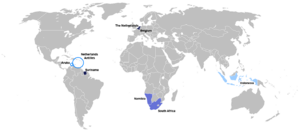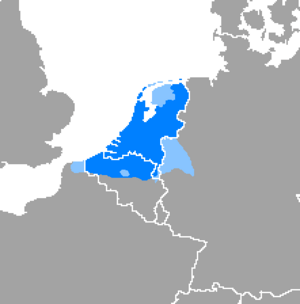Dutch language facts for kids
Quick facts for kids Dutch |
||||
|---|---|---|---|---|
| Nederlands | ||||
| Native to | Netherlands and Flanders | |||
| Region | Netherlands, Belgium, and Suriname; also in Aruba, Curaçao, Sint Maarten, French Flanders |
|||
| Ethnicity | ||||
| Native speakers | 22 million (2016)e19 Total (L1 plus L2 speakers): 28 million (2018) |
|||
| Language family |
Indo-European
|
|||
| Early forms: |
Old Dutch
|
|||
| Writing system |
|
|||
| Official status | ||||
| Official language in |
|
|||
| Regulated by | Nederlandse Taalunie (Dutch Language Union) |
|||
| Linguasphere | 52-ACB-a | |||

Dutch-speaking world (included are areas of daughter-language Afrikaans)
|
||||

Distribution of the Dutch language and its dialects in Western Europe
|
||||
|
||||
Dutch (which is called Nederlands by its speakers) is a West Germanic language. It comes from the Netherlands and is the country's official language. You can also hear it spoken in the northern part of Belgium, a region known as Flanders. In South America, Dutch is spoken in Suriname.
Did you know that a language called Afrikaans grew from Dutch? It's spoken mainly in South Africa and Namibia. Around 22 million people worldwide speak Dutch as their first language. If you add those who speak it as a second language, the number goes up to 28 million!
Contents
Discovering the History of Dutch
Dutch is part of the West Germanic language family. This family also includes English, Frisian, and German. That's why Dutch shares many words and grammar rules with English. However, it looks even more like German.
The North Germanic languages are also related. These include Danish, Norwegian, Swedish, and Icelandic. Dutch has some similarities with these languages too.
From Old to Middle Dutch
The Dutch language has changed a lot over time. Before the year 1170, it was called Old Dutch (Oudnederlands). From 1170 to 1500, it became Middle Dutch (Middelnederlands), also known as Diets. This is where the English word "Dutch" comes from!
The word "Dutch" comes from an old word, theodiscus. This word meant "language of the common people." Long ago, it was used for both Germans and their language. Over time, in English, "Dutch" came to mean only the language of the Netherlands. The Dutch word for German, Duits, comes from the same old root.
The oldest known Dutch book is Wachtendonckse Psalmen, written around the year 900. The first Dutch writer we know by name is Hendrik van Veldeke, who was born about 1150.
Understanding Dutch Letters and Sounds
Dutch uses the same Roman alphabet (letters) as English. But some letters sound a bit different!
Vowel Sounds in Dutch
Vowels can be short or long. Here's how some of them sound:
| Short | Long |
|---|---|
| a – like the a in art. | aa – somewhat like the "i" in Fire |
| e – like in pet | ee – like the "a" in space |
| o – like in organic | oo – like in no |
| u – somewhat like the "e" in the | uu – like the "ü" in the German word für |
| i – like in lip | ie – like in piece |
- Note:* The letter 'e' can also sound like the 'e' in the (a very soft sound called a schwa).
Here are some other vowel combinations:
- oe – like the "ou" in you
- eu – like the French "eu" in fleur
- ui – a unique Dutch sound, similar to the French word oeil (eye)
- ou/au – like in sound
- ij/ei – another unique Dutch sound, similar to "ej" in Esperanto
- aai – like the "i" in ice
- eeuw – a typical Dutch sound
- ieuw – somewhat like "iew" in view
Consonant Sounds in Dutch
Most consonants are similar to English, but some are different:
- b
- c
- d
- f
- g/ch – This sound is made at the back of your throat, almost like a scratching sound. In the south of the Netherlands, it's a "soft G," while in the north, it's a "hard G."
- h
- j – like "y" in you
- k
- l
- m
- n
- p
- q – rarely used, sounds like 'k'
- r – not like English; it's a more rolling 'r' sound
- s
- t
- v
- w
- x – rarely used, mostly in foreign words, sounds like 'ks'
- z
- Important note:* When a word ends with "-d", it is often pronounced like "-t". For example, "hand" (hand) sounds like "hant".
Exploring Dutch Grammar
Dutch grammar is a bit different from English. The order of words in complex sentences can change. The simplest sentence structure is "Subject - Verb." Dutch has fewer main verb tenses than English. The most common ones are:
- onvoltooide tegenwoordige tijd (present simple)
- onvoltooide verleden tijd (past simple)
- voltooide tegenwoordige tijd (present perfect)
- voltooide verleden tijd (past perfect)
Present Simple (Onvoltooid tegenwoordige tijd)
The present simple (ott) is used for things happening now or regularly. Most verbs change in a regular way (these are called regelmatige werkwoorden). The main part of the verb, called the stem, stays the same in most changes.
Here's how to change the verb "lopen" (to walk):
| Person | How the verb changes | Example with "lopen" (to walk) |
|---|---|---|
| Ik (I) | Stem | Ik loop (I walk) |
| Jij (you) | Stem+t | Jij loopt (You walk) |
| Hij/Zij (He/She) | Stem+t | Hij loopt (He/She walks) |
| Wij (we) | stem+en* (infinitive) | Wij lopen (We walk) |
| Zij (they) | stem+en* | Zij lopen (They walk) |
| Jullie (you, plural) | stem+en* | Jullie lopen (You all walk) |
| U (you, polite) | stem+t' | U loopt (You walk - polite) |
- Note:* The stem of a verb is usually the infinitive (the "to" form) without the final -en.
Past Simple (Onvoltooid verleden tijd)
The past simple (ovt) is used for actions that happened in the past. Changing verbs in the past tense can be tricky. Some verbs add a 'D', while others add a 'T'. There's a helpful rule called 't kofschip.
If the verb's stem (the part without '-en') ends with a consonant found in "'t kofschip" (t, k, f, s, ch, p), you add a 'T'. Otherwise, you add a 'D'.
- Example with 'T' (praten - to talk):* The stem "prat" ends with 't', which is in "'t kofschip".
| Person | Verb change (with T) | Result with praten |
|---|---|---|
| Ik | stem+te | Ik praatte (I talked) |
| Jij | stem+te | Jij praatte (You talked) |
| Hij/Zij | stem+te | Hij praatte (He/She talked) |
| Wij | stem+ten | Wij praatten (We talked) |
| Zij (they) | stem+ten | Zij praatten (They talked) |
| Jullie | stem+ten | Jullie praatten (You all talked) |
| U | stem+te | U praatte (You talked - polite) |
- Example with 'D' (vrezen - to fear):* The stem "vrez" ends with 'z', which is NOT in "'t kofschip".
| Person | Verb change (with D) | Result with Vrezen |
|---|---|---|
| Ik | stem+de | Ik vreesde (I feared) |
| Jij | stem+de | Jij vreesde (You feared) |
| Hij/Zij | stem+de | Hij vreesde (He/She feared) |
| Wij | stem+den | Wij vreesden (We feared) |
| Zij (they) | stem+den | Zij vreesden (They feared) |
| Jullie | stem+den | Jullie vreesden (You all feared) |
| U | stem+de | U vreesde (You feared - polite) |
Continuous Actions in Dutch
While English uses "-ing" (like "I am eating"), Dutch usually says "Ik eet" (I eat). However, there's a common way to show an action is happening right now and isn't finished:
- You use a form of zijn (to be) + aan het + the infinitive verb.
- For example: Ik ben aan het lopen means I am walking (right now).
Learning Basic Dutch Words
Here are some common Dutch words and phrases to get you started:
- hallo (hello)
- Ik heet ... (my name is...)
- Ik hou van je (I love you)
- ja (yes)
- nee (no)
Counting in Dutch
Let's learn the numbers from one to twelve:
- een (one)
- twee (two)
- drie (three)
- vier (four)
- vijf (five)
- zes (six)
- zeven (seven)
- acht (eight)
- negen (nine)
- tien (ten)
- elf (eleven)
- twaalf (twelve)
For numbers like 100, the Dutch word is honderd, which means "hundred".
Useful Dutch Expressions
This table shows some helpful phrases you might use:
| Dutch | English |
|---|---|
| Hallo | Hello |
| Hoi | Hi |
| Dag | Bye (formal) |
| Doei! | Bye! (informal) |
| Tot later! | See you later! |
| Goedemorgen/Goedemiddag | Good morning/Good afternoon |
| Goedenavond/Goedenacht | Good evening/Good night |
| Hoe gaat het met je? | How are you? (informal) |
| Hoe gaat het met u? | How are you? (formal) |
| Met mij gaat het goed! | I am fine! |
| Dank je/Dank u | Thank you (informal/formal) |
| Graag gedaan | You are welcome |
| Spreekt u Engels? | Do you speak English? |
| Spreekt u Nederlands? | Do you speak Dutch? |
| Ik begrijp het niet | I do not understand |
| Tot ziens | Goodbye |
| Mijn naam is... | My name is... |
| Ik ben... | I am... |
| Alsjeblieft | Please (informal) |
| Alstublieft | Please (formal) |
| Wat is je naam? | What is your name? (informal) |
| Wat is uw naam? | What is your name? (formal) |
| Waar kom je vandaan? | Where are you from? (informal) |
| Waar komt u vandaan? | Where are you from? (formal) |
| Ik kom uit Nederland/België | I'm from the Netherlands/Belgium |
| Wat is er? | What's wrong? |
| Sorry, waar is het station? | Excuse me, where is the train station? |
| Hoeveel kost deze trui? | How much is this sweater? |
| Mevrouw | Miss/Mrs. |
| Meneer | Mr. |
See also
 In Spanish: Idioma neerlandés para niños
In Spanish: Idioma neerlandés para niños
Images for kids
-
A long Dutch word, hemelwaterinfiltratiegebied (rainwater infiltration area), on a sign in Zwolle, Netherlands.









